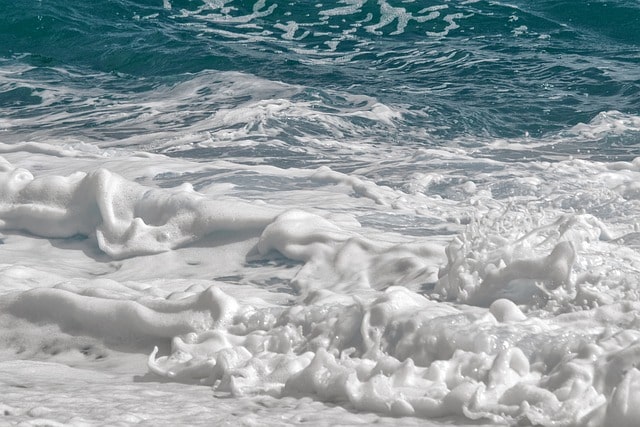Sea foam green is a soft, pale green-blue color that is reminiscent of the foam on the ocean’s surface. Here are the key points about sea foam green:
- Seafoam green has a hex code of #93E9BE, with RGB values of 147, 233, 190 and CMYK values of C: 39 M:0 Y:35 K: 0.
- It is a mixture of green and blue with a small amount of grey, giving it a soft, muted appearance. The green tones are dominant, making it look refreshingly bright but still soft.
- Seafoam green is often confused with mint green, but they are considered distinct colors with mint green having a hex code of #98FF98.
- The name “sea foam green” comes from the lighter color notes of the sea and the sparkles of the ocean, rather than the actual white color of sea foam.
- Seafoam green has been used since the 1700s but gained more popularity in the 1950s, when it was widely used for clothing, cars, and furniture.
- Psychologically, sea foam green is associated with calmness, relaxation, freshness, vitality, and harmony with nature. It is seen as a soothing, revitalizing color.
- Seafoam green pairs well with a variety of colors like blues, greens, whites, tans, and pinks to create calming, nature-inspired palettes.
In summary, sea foam green is a soft, serene color that evokes the natural beauty of the ocean and promotes feelings of tranquility and renewal.
What is sea foam made of?
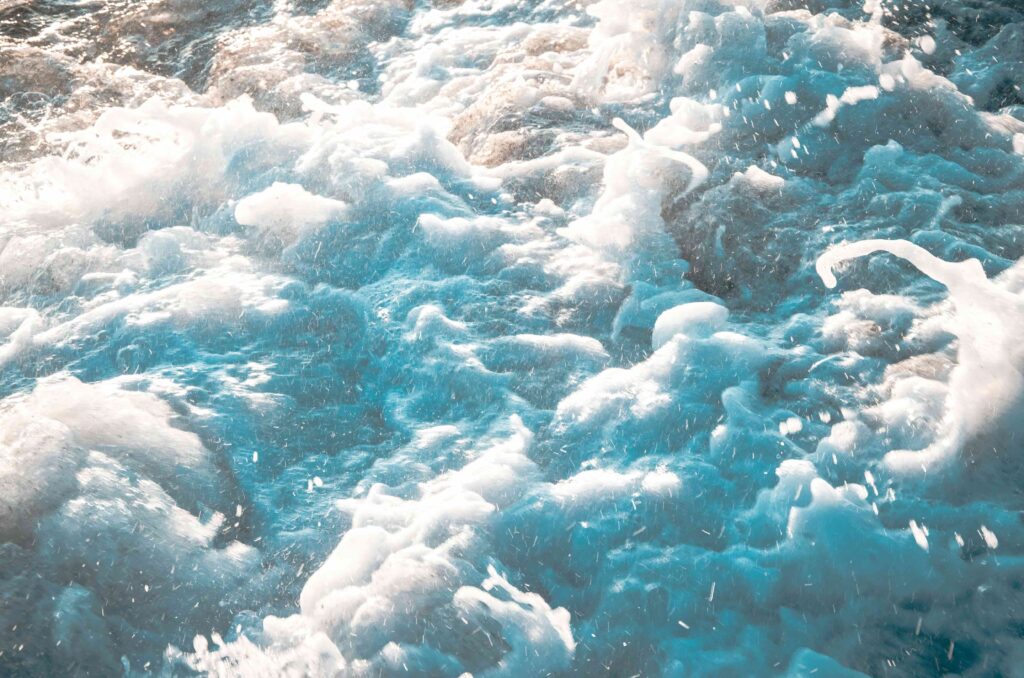
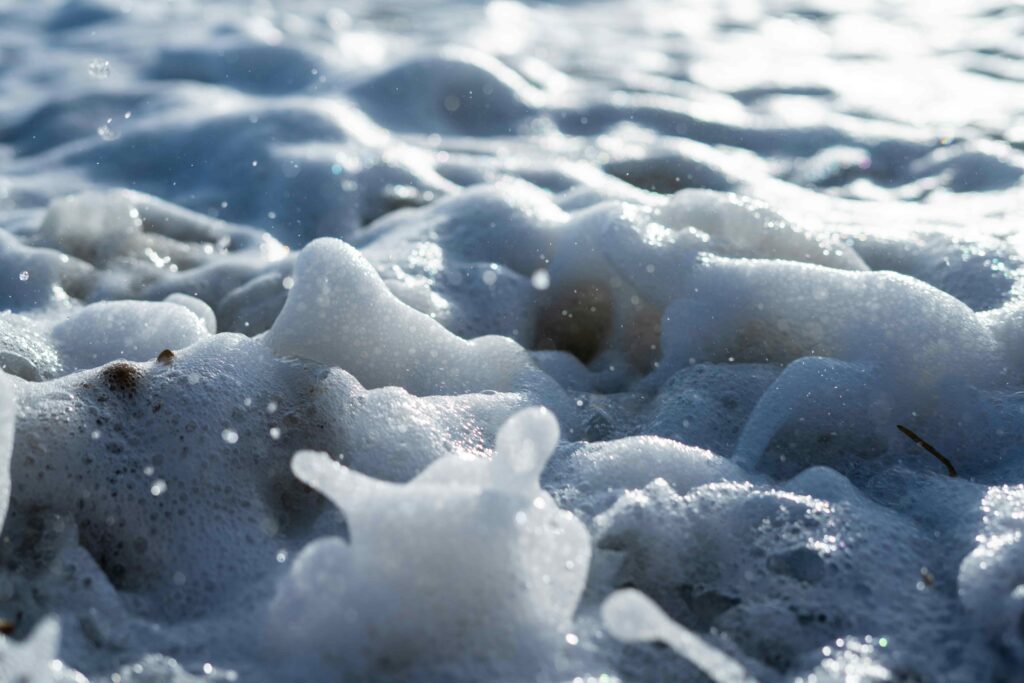
It is a type of foam created by the agitation of seawater, particularly when it contains higher concentrations of dissolved organic matter (DOM). Proteins, lignins, and lipids from sources such the offshore breakdown of algal blooms can be included in this DOM.
These compounds act as surfactants or foaming agents, trapping air and forming persistent bubbles that stick together through surface tension. The location and possible effects of the adjacent freshwater, marine, and/or terrestrial habitats influence the composition of these. It can contain a mixture of decomposed organic materials, including zooplankton, phytoplankton, algae, bacteria, fungi, protozoans, and vascular plant detritus.
In some areas, it is found to be primarily composed of protein, lipids, and carbohydrates, with a small fraction of organic carbon containing phenolics, sugars, amino sugars, and amino acids. It can also contain contaminants such as petroleum compounds, pesticides, and herbicides, which can be coated onto or contained within the foam bubbles. These contaminants can be introduced through human activities such as the production, transport, or spillage of petroleum products or detergents.
In summary, it is a mixture of organic matter and surfactants that forms when seawater is agitated by wind and waves, trapping air and creating persistent, fluffy-like foam.
Seasonal variations in sea foam composition
Seasonal variations in these composition have been studied in several regions. The composition of these can change significantly over the course of a year, influenced by factors such as changes in phytoplankton blooms, zooplankton populations, and terrestrial inputs like pollen.
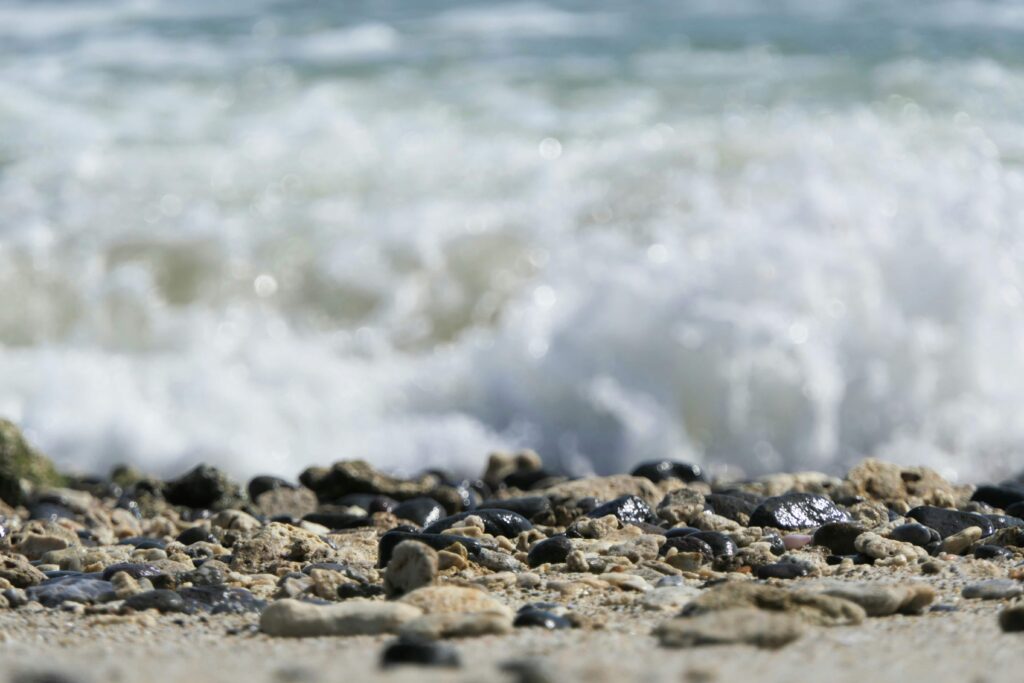
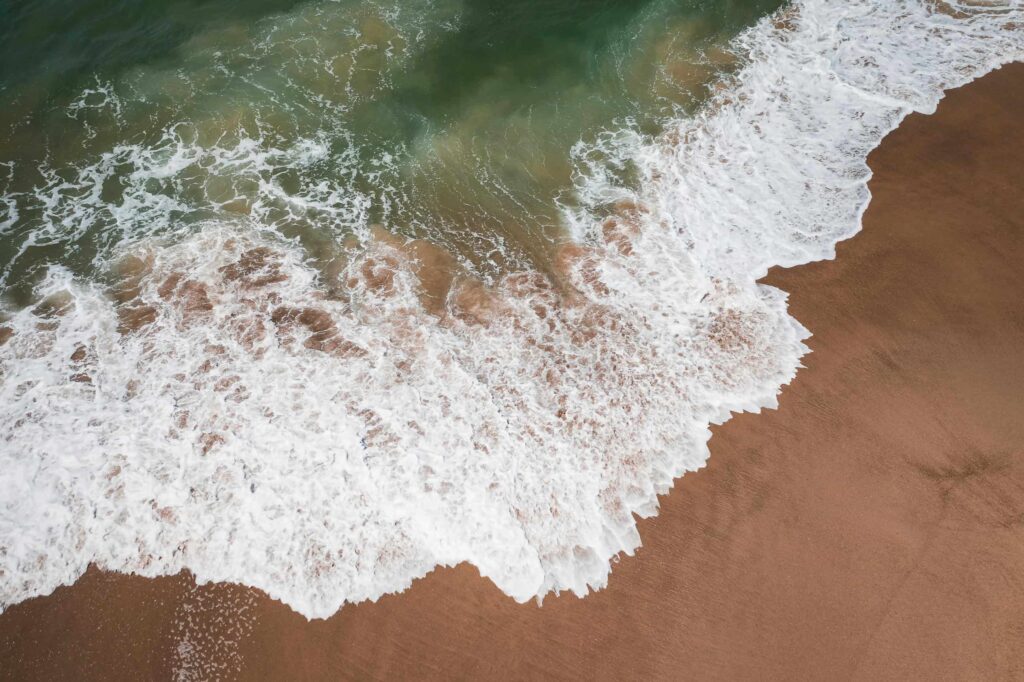
.
Key Findings:
Phenolics and Sugars:
Seasonal fluctuations in the content of phenolics, sugars (total or bound), and free amino sugars were significantly correlated with organic carbon content in them.
Amino Acids and Amino Sugars:
The Bay of Fundy, for example, experiences high mortality rates of an abundant tube-dwelling amphipod (*Corophium volutator*) by natural die-offs and predation by migrating seabirds, which contributes to the release of amino sugars in the surrounding environment and thus in sea foam.
Phytoplankton Blooms:
The composition increases dramatically during phytoplankton blooms in certain areas. These blooms can lead to high concentrations of microplankton, particularly autotrophic phytoplankton, in these.
Bacterial Composition:
Old sea foam tends to have a higher density of bacteria compared to fresh foam. The bacterial composition in sea foam can also vary seasonally, with some studies showing that 95% of sea foam bacteria are rod-shaped, whereas the surrounding surface water contains mostly coccoid-form bacteria.
Terrestrial Inputs:
In some regions, seasonal variations in sea foam composition can be influenced by terrestrial inputs like pollen, which can alter its chemistry.
Conclusion:
Seasonal variations in sea foam composition are influenced by a range of factors, including changes in phytoplankton and zooplankton populations, terrestrial inputs, and bacterial composition. These variations can have significant implications for the ecological and chemical properties of sea foam.
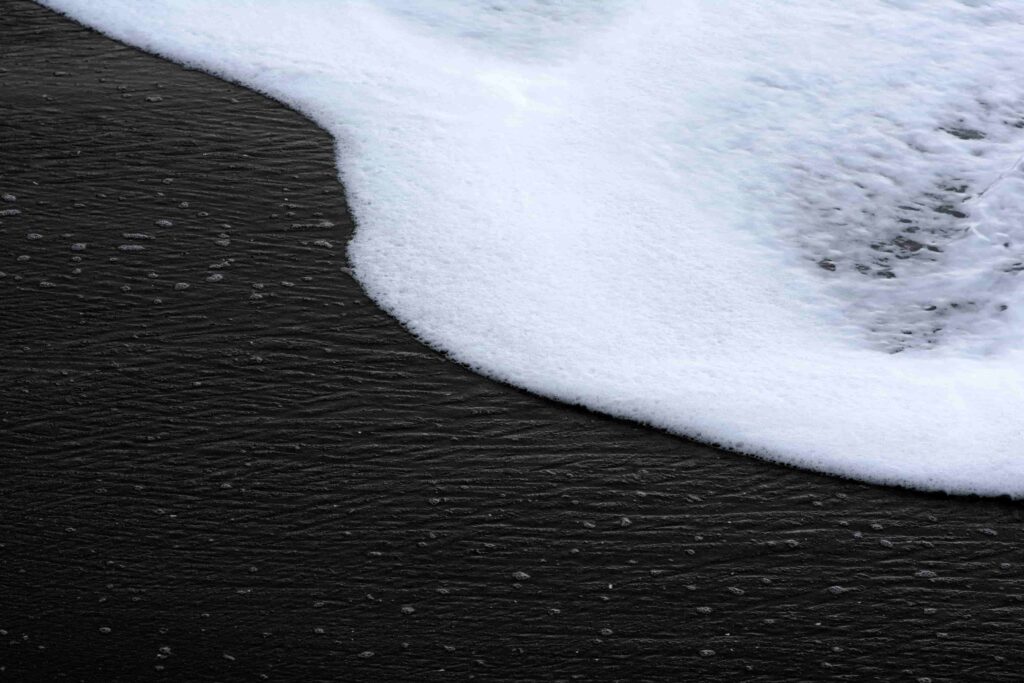

How to make sea foam green?
To make sea foam green, you can follow various methods depending on the medium you are working with. Here are some steps for different mediums:
Painting:
Acrylics:
For a seafoam green color in acrylics, you can mix a combination of yellow ochre, blue, and white. Start with a base of yellow ochre and add small amounts of blue and white until you achieve the desired shade.
Watercolors:
For watercolors, mix a combination of yellow ochre, blue, and a touch of green. Start with a base of yellow ochre and add small amounts of blue and green until you achieve the desired shade.
Ceramics:
Glaze:
For a seafoam green glaze, you can use a recipe that includes dolomite, gerstley borate, talc, Custer Feldspar, OM 4 Ball Clay, silica, cobalt carbonate, and green chrome. This glaze is fired to cone 10 in reduction in a gas kiln and works well layered over Zacks Black.
Digital Design:
Hex Code:
For digital designs, you can use the hex code #93E9BE, which represents the exact color seafoam green. This code can be used in various design software and applications.
General Tips:
Color Mixing:
When mixing colors, it is essential to start with a base color and gradually add small amounts of other colors until you achieve the desired shade. This helps to avoid over-saturation and ensures a more balanced color.
Experimentation:
Feel free to experiment with different ratios of colors to achieve the perfect seafoam green shade for your specific project.
By following these steps and tips, you can create a beautiful sea foam green color in various mediums.
What is sea foam good for?
Sea Foam is a well-known and trusted treatment for car engines, particularly effective when used in gasoline or diesel fuels and fuel blends. It has several benefits and uses, including:
Cleaning Carbon Build-up:
Sea Foam helps clean carbon deposits and sludge from hard-to-reach parts of the engine, making it easier to remove and maintaining the engine’s performance.

Lubrication:
It lubricates the fuel system and other moving parts of the vehicle, ensuring smooth operation and reducing wear and tear.
Fuel System Maintenance:
Regular use of Sea Foam helps maintain the fuel system, keeping it clean and free from deposits that can cause engine problems.
Stabilizing Fuel:
Sea Foam can stabilize stored fuel for up to two years, preventing degradation and maintaining its quality.
Moisture Control:
It helps control moisture levels in the fuel system, which can prevent issues like thickening diesel fuel.
Cleaning Fuel Injectors and Carburetors:
Sea Foam cleans fuel injectors and carburetor passageways, ensuring proper fuel flow and preventing engine misfires.
Quiet Noisy Lifters:
Adding Sea Foam to the oil can quiet noisy lifters by removing oil varnish and cleaning up sludge.
Removes Varnish and Sludge:
Sea Foam breaks up and dissolves contaminants like varnish and sludge, which can harm engine performance and longevity.
Safe for All Engines:
Sea Foam is safe for use in all gasoline and diesel engines, without containing harsh detergents or abrasive chemicals.
Overall, Sea Foam is a versatile and effective treatment that can be used in various ways to maintain and improve the performance of car engines.
What is the disadvantage of Sea Foam?
The main disadvantages of Sea Foam are:
Fouling Spark Plugs:
Sea Foam can foul spark plugs, which may require replacement after use.
Carbon Buildup Removal:
In older, high-mileage engines, Sea Foam can remove carbon buildup from valves, which can be a problem if the engine relies on this buildup for proper operation.

Potential for Increased Oil Consumption:
Sea Foam can increase oil consumption in some engines, potentially leading to more frequent oil changes.
Potential for Increased Emissions:
Sea Foam can also increase emissions in some engines, particularly if the engine is not properly maintained or if the Sea Foam is not used correctly.
Potential for Overuse:
Sea Foam should be used in moderation, as overuse can lead to negative effects on engine performance and longevity.
These disadvantages highlight the importance of proper use and understanding of Sea Foam to ensure its benefits are maximized while minimizing potential negative effects.
How do you apply Sea Foam?
To apply Sea Foam, you can follow these steps based on the specific use case:
For Fuel System Maintenance and Cleaning:
Regular Maintenance:
To ensure consistent fuel system upkeep, incorporate 1 ounce of Sea Foam for every gallon of fuel.This helps maintain a clean fuel system and ensures smooth engine operation.
Cleaning:
For cleaning, use 2 or more ounces of Sea Foam per gallon of fuel. The more you add, the better it cleans. Add when the tank is low to maximize the cleaning concentration.
For Engine Oil:
Adding to Oil:
For engine oil, remove the oil filler cap and pour the recommended amount of Sea Foam directly into the engine crankcase. Add 1 ounce of Sea Foam for each quart of oil in the crankcase. For optimal cleaning outcomes, drive 100 to 300 miles prior to each oil and filter replacement.
For Fuel Injectors and Carburetors:
Spray Application:
For cleaning fuel injectors and carburetors, use Sea Foam Spray. Spray the Sea Foam directly into the throttle body, ensuring it reaches the fuel injectors and carburetor passageways. This helps remove harmful residues and deposits from these critical areas.
For Stabilizing Fuel:
Fuel Storage:
For stabilizing fuel for storage, use 1 ounce of Sea Foam per gallon of fuel. This helps maintain the quality of the fuel and prevents degradation over time.
Summary:
Fuel System Maintenance:
Add 1 ounce of Sea Foam per gallon of fuel for regular maintenance.
Cleaning:
Use 2 or more ounces of Sea Foam per gallon of fuel for cleaning.
Engine Oil:
Add 1 ounce of Sea Foam for each quart of oil in the crankcase.
Fuel Injectors and Carburetors:
Use Sea Foam Spray to clean these areas.
Fuel Storage:
Use 1 ounce of Sea Foam per gallon of fuel for stabilizing fuel for storage.
Is Sea Foam good for skin?
Sea Foam is beneficial for skin due to its unique composition and properties. Here are some key points:
Hydration and Softening:
Sea Foam contains squalane, which hydrates and softens the skin, leaving it looking smooth and supple.
Detoxification and Nourishment:
The seaweed in Sea Foam is rich in minerals, which helps detoxify, rejuvenate, and nourish the skin.
Antioxidant Properties:
Sea Foam contains antioxidants like white tea, which help protect the skin from environmental stressors and promote a healthy, radiant complexion.
Removes Impurities:
Sea Foam effectively removes makeup, oil, and impurities, leaving the skin clean and refreshed.
Skin Barrier Restoration:
Sea Foam helps restore the skin barrier, leaving the skin feeling soft and clean.
Anti-Aging Benefits:
The white pearl powder in Sea Foam has anti-aging benefits, protecting the skin from external aggressors like the sun, cold, and pollution, and stimulating cell regeneration.
Suitable for All Skin Types:
Sea Foam is suitable for all skin types, including sensitive skin, and can be used both morning and night. Overall, Sea Foam is a beneficial skincare product that can help maintain healthy, hydrated, and radiant skin.
Best sea foam products for sensitive skin
For sensitive skin, the best sea foam products are those that are gentle, non-irritating, and provide effective cleansing without harsh chemicals. Here are some top recommendations:

Pacifica Sea Foam Complete Face Wash:
This sulfate-free cleanser is formulated with coconut water, sea algae, and white tea to gently remove makeup, oil, and impurities while providing antioxidant benefits. All skin types, even those with sensitive skin, can use it.
Thalissi Baltija SEA FOAM:
This product contains white pearl powder, which helps protect the skin from external aggressors like the sun, cold, and pollution. It also stimulates the skin’s active resistance to these conditions, making it a great option for sensitive skin.
VT Cosmetics CICA x HYALON Cica Mild Foaming Cleanser:
This dermatologist-recommended cleanser is known for its gentle, foaming texture that effectively cleanses without leaving any residue. It is formulated with Cica Mild and HA, which provide immediate cleansing and hydration, making it suitable for sensitive skin.
These products are designed to provide gentle, effective cleansing without harsh chemicals, making them suitable for sensitive skin.

Is Sea Foam safe?
Yes, sea foam is generally safe for humans and animals. It is a natural occurrence that forms when the ocean is agitated by wind and waves, and it is often an indication of a productive ocean ecosystem.
Contact Us for any Question related to this Article.
Frequently Asked Questions
What is sea foam?
Sea foam is a type of foam that forms on the surface of the ocean when it is agitated by wind and waves. It is often an indication of a productive ocean ecosystem.
What is sea foam green?
Seafoam green is a soft, pale green-blue color reminiscent of the foam on the ocean’s surface. It is often used in design, fashion, and art to evoke a sense of calmness and serenity.
What is sea foam made of?
Sea foam is primarily composed of dissolved organic matter (DOM) such as proteins, lignins, and lipids from sources like algal blooms, zooplankton, and terrestrial inputs. These compounds act as surfactants, trapping air and forming persistent bubbles.
Are there seasonal variations in sea foam composition?
Yes, sea foam composition can vary seasonally due to changes in phytoplankton blooms, zooplankton populations, and terrestrial inputs like pollen. These variations can impact the ecological and chemical properties of sea foam.
How do you make sea foam green?
To make sea foam green, you can mix a combination of yellow ochre, blue, and white in painting, or use a specific glaze recipe in ceramics. For digital design, use the hex code #93E9BE.
What is sea foam good for?
Sea Foam is a well-known treatment for car engines, helping to clean carbon deposits, lubricate the fuel system, and stabilize fuel. It is also used in skincare products for its hydrating, nourishing, and antioxidant properties.
What are the disadvantages of sea foam?
Sea Foam can foul spark plugs, remove carbon buildup from valves, increase oil consumption, and increase emissions in some engines. It should be used in moderation and with proper understanding to avoid negative effects.
How do you apply sea foam?
Sea Foam can be applied in various ways, including adding it to fuel, engine oil, or using it as a spray for fuel injectors and carburetors. The recommended amount and method vary depending on the specific use case.
Is sea foam good for skin?
Yes, sea foam is beneficial for skin due to its hydrating, nourishing, and antioxidant properties. It can help detoxify, rejuvenate, and protect the skin, making it suitable for all skin types, including sensitive skin.
What are the best sea foam products for sensitive skin?
Pacifica Sea Foam Complete Face Wash, Thalissi Baltija SEA FOAM, and VT Cosmetics CICA x HYALON Cica Mild Foaming Cleanser are top recommendations for sensitive skin. These products are gentle, non-irritating, and provide effective cleansing without harsh chemicals.
Is sea foam safe?
Yes, sea foam is generally safe for humans and animals. It is a natural occurrence that forms when the ocean is agitated by wind and waves, and it is often an indication of a productive ocean ecosystem.
